Scotch Macaskill's Wildlife Blog
IMPORTANT: Please note that from April 2009 this Blog's Web address changed as a result of a switch in the blogging platform we use. It's still an integral part of the Wildlife Pictures Online website and, we hope, will continue providing entertaining and enjoyable content in the form of wildlife images, news, views and information.
For the most recent posts, links, and other resources, please visit the new Wldlife Photography Blog.
|
Warthog Pictures added to Gallery
October 18, 2005
|
A new page, featuring 15 warthog pictures, has
been added to the Gallery section of the main site.
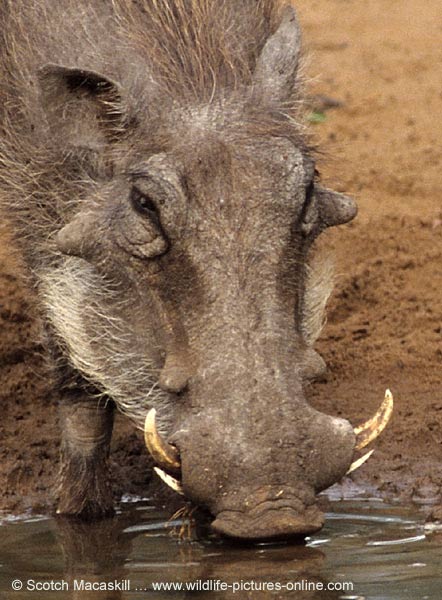
Warthog may not be the most attractive of animals, but provide plenty of entertainment for anyone on safari to a game reserve or national park, particularly when they scurry
about with their tails sticking straight up like antenna on four-legged radios. Check out the Gallery for more about these wild hogs
|
Life of Popular WildCam Extended
October 18, 2005
|
Good news for fans of National Geographic's WildCam at Pete's Pond, Mashatu Game Reserve, is that the cam
will now continue operating until December 8.
The original intention was to close down the cam sometime in October, or certainly once the summer rains started, but such has been the popularity of the cam that its life has been extended.
For those of you who are not familiar with the WildCam, it's been placed in a "hide" at a small dam called Pete's Pond in the Mashatu Game Reserve in Eastern Botswana.
At this time of year it's very dry in Mashatu, so animals have to rely on any water that's available.
Most of the natural waterholes or streams have dried up, so the pond is one of the few places where the resident
wildlife can find water.
This makes for excellent viewing, as a wide variety of animals have been arriving to drink, including elephant,
a selection of antelope, zebra, giraffe, wildebeest, hyena, warthog, jackals, plus numerous bird species.
I'm finding it specially fascinating as I've visited Pete's Pond and have taken pictures from the hide .....read more. Below are pictures showing the hide and the pond:
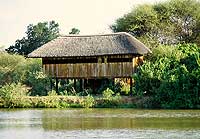
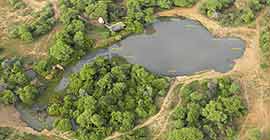
|
Elephant close-up, Mashatu Game Reserve
October 18, 2005
|
Today's picture: Close-up of an African elephant cow, Mashatu Game Reserve, Botswana.
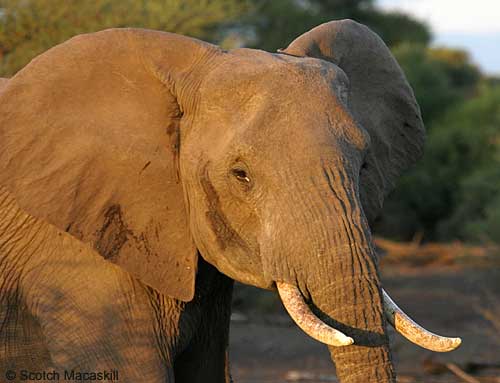
Photo Details:: African elephant (Loxodonta africana) female, late afternoon,
Mashatu Game Reserve, Botswana.
Camera: Canon EOS Digital Rebel (300D)
Lens: Canon 100-400mm IS zoom
Focal Length: 235mm
Shutter Speed: 1/320
Aperture: f 5.6
ISO: 800
|
Digital SLR vs 8-megapixel Fixed-lens Camera
October 19, 2005
|
Can today's top-of-the-range "point-and-shoot" (ie fixed lens) digital cameras provide a viable alternative
to a digital SLR?
That's a question wildlife and nature photographers need to ask themselves.
It's certainly something I've been pondering. I could sell my Canon digital SLR and lenses, buy a
Panasonic Lumix DMC-FZ30 ($609 from Adorama) and have enough cash left over to take a
fantastic photo safari to Tanzania's Serengeti or the Masai Mara in Kenya - places I have always longed to visit but are beyond my budget.
The Lumix DMC-FZ30 is an 8-megapixel camera (same as my Canon EOS 350D) and comes with an image-stabilized 12x zoom (35-420mm equivalent).
In addition, this is a Leica lens, with a maximum aperture of F2.8 to F3.7. See pic below:
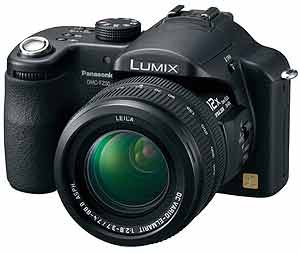
Does that really mean that at full zoom you're shooting with something akin to a Leica 420mm F3.7 lens? Good question!
So I was fascinated to read an in-depth shoot-out between a Canon EOS-20D and the Panasonic Lumix DMC-FZ30 (article unfortunately no longer available).
For more about the latest model of this camera, the Panasonic Lumix DMC-FZ200, and why it makes a viable alternative to a DSLR as a wildlife camera, see
Top Superzooms for Wildlife Photography.
|
Inquisitive Lion Cub
October 19, 2005
|
Today's picture: Lion cub with its mother's tail in the foreground, Lower Zambezi National Park, Zambia.
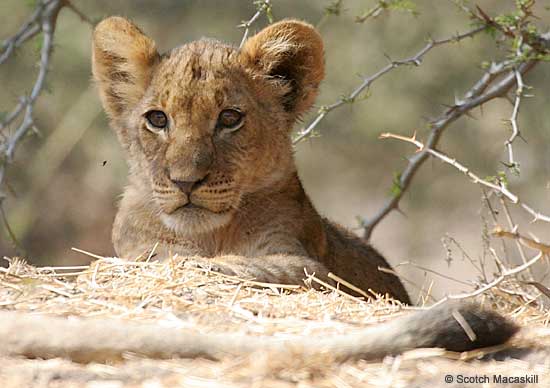
Photo Details:: Lion cub (Panthera leo), one of three in the litter, peering over top of a bank where it and its siblings were resting in the shade with two adult lionesses, Lower Zambezi National Park, Zambia.
Camera: Canon EOS Digital Rebel (300D)
Lens: Canon 100-400mm IS zoom
Focal Length: 400mm
Shutter Speed: 1/1000
Aperture: f 5.6
ISO: 800
|
Today's picture: Baboon with Grass Stem - A Gift or Peace Offering?
October 20, 2005
|
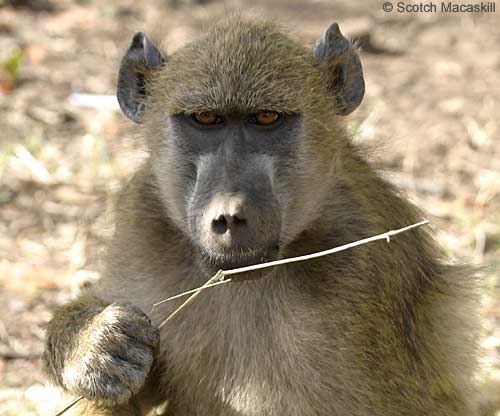
Photo Details:: Chacma Baboon (Papio ursinus) male, near Victoria Falls, Zambia.
Camera: Canon EOS Digital Rebel;
Lens: Canon 100-400mm IS zoom;
Focal Length: 170mm;
Shutter Speed: 1/250;
Aperture: f5.6;
ISO: 400
|
Today's picture: Giraffe in warm afternoon light, Mashatu Game Reserve.
October 21, 2005
|
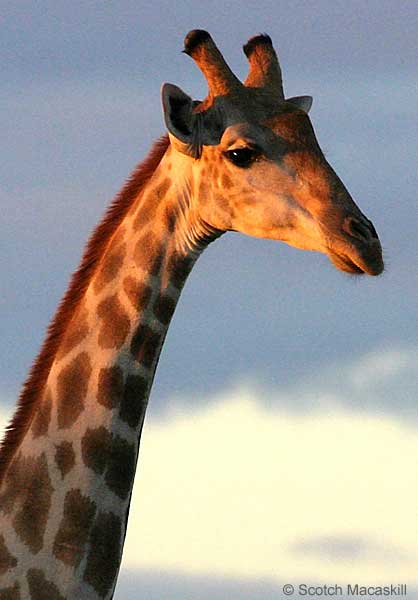
Photo Details:: Giraffe (giraffa camelopardalis) close-up with blue sky and puffy
clouds in background, late afternoon in Mashatu Game Reserve, Tuli BlocK, Botswana.
Camera: Canon EOS Digital Rebel;
Lens: Canon 100-400mm IS zoom;
Focal Length: 400mm;
Shutter Speed: 1/400;
Aperture: F7.1;
ISO: 800.
|
Today's picture: Vervet Monkey - sad, or maybe just pensive? Mashatu Game Reserve, Botswana.
October 22, 2005
|
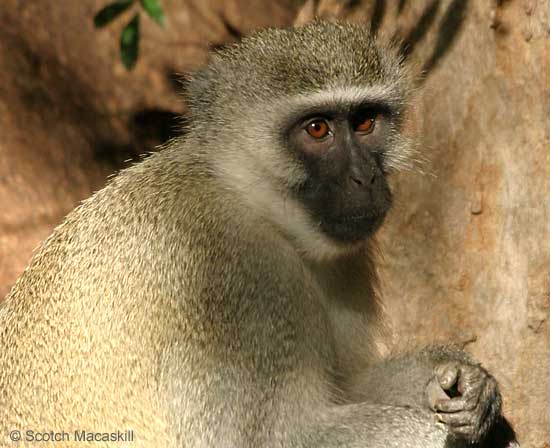
Photo Details:: Vervet Monkey (Cercopithecus aethiops) sitting in tree looking
pensive, Mashatu Game Reserve, Tuli BlocK, Botswana.
Camera: Canon EOS Digital Rebel;
Lens: Canon 100-400mm IS zoom;
Focal Length: 400mm;
Shutter Speed: 1/400;
Aperture: f6.3;
ISO: 400
Tip for Photographing Monkeys:
A problem when taking pictures of monkeys is the contrast between their light grey bodies and black faces.
Your camera's meter is likely to expose for the grey body, so the small face and dark eyes will be underexposed, showing very little detail.
You can compensate for this by using fill-in flash. This should add some detail to the dark face and also put a highlight or "catchlight" in the eyes, which always increases the sparkle and vitality of animal pictures. The trick is not too add too much flash, which will make the photograph look artificial and possibly "blow out" the hightlights.
Of course, if the monkey is sitting with angled sunlight on its face, naturally lightening the dark areas and adding a catchlight to one or both eyes, then you're in luck. In the picture above, there was some angled light on the subject, plus light reflected off the surrounding branches, which helped balance the light body and dark face.
|
Today's picture: Leopard looking straight at camera - Mashatu Game Reserve, Botswana.
October 24, 2005
|
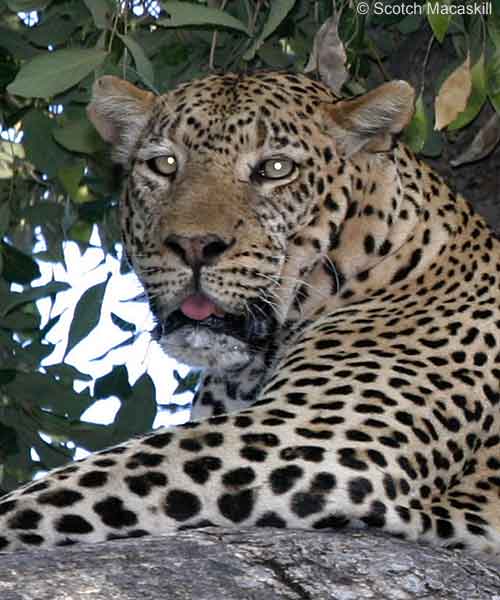
Photo Details:: Leopard (Panthera pardus) lying in tree looking directly at the
camera, Mashatu Game Reserve, Tuli BlocK, Botswana.
Camera: Canon EOS Digital Rebel;
Lens: Canon 100-400mm IS zoom;
Focal Length: 285mm;
Shutter Speed: 1/200;
Aperture: f6.3;
ISO: 800
Taking Leopard Pictures
Finding a leopard to photograph in the wild is the first hurdle - they're elusive, nocturnal animals, so generally don't lie around in the open during daylight waiting to be photographed.
Once you find a subject, you'll likely face additional problems.
The magnificent male leopard in the picture above was lying full stretch on a thick branch in dappled shade. We spotted him by chance as we slowed to climb a steep bank and happened to look up into the the branches of a tree immediately ahead and to our left.
Although we had a good, relatively unobstructed view, it was nevertheless a challenge taking pictures:
- you're in a game-drive vehicle, so have to position yourself and the camera within the confines of the
vehicle - in this case shooting upwards at a fairly acute angle;
- you're using a long lens, in this case a 100-400 zoom (equal to a 160 - 640mm on a Canon 300D), so
it's essential you support the camera and lens - no hand-holding possible at that magnification. Again, not
easy or comfortable when you're shooting upwards and your areas of support for the camera is something
like the vehicle door or window sill.
- you're with other people, which means slight but constant movement of the vehicle - so camera shake is
a major problem when shooting with a long lens.
- your subject, beautiful as it is, has dappled markings that blend in with the background and surrounding
dappled shade.
To overcome as many of these hurdles as possible, I used a "bean-bag" to support the camera and lens,
pushed my ISO to 800 to allow for the fastest shutter speed possible, and also took some pictures with a
camera-mounted flash to fill in the shadows and reduce the contrast.
The main leopard photo above (a tight crop of the full-size image) was one of the "fill-flash" series, as you can see by
the large highlights in the leopard's eyes.
This is a problem with a flash mounted on the camera - it's a bit like red-eye in people. If I could have
had the flash mounted some distance to the side of the camera, then the harsh, unnatural highlights in the
eyes could have been avoided.
But in this case it was difficult enough trying to keep the camera steady, without thinking about trying to
mount a flash somewhere in the vehicle. Such are the hazards of the amateur wildlfe photographer!
Below is a picture of renowned South African photographer Nigel Dennis at work photographing a
leopard (from his book,
Getaway Guide to Wildlife Photography.) Note the array of cameras, all firmly mounted on the
vehicle, plus the powerful flash with tele extender attached, mounted to the side of the main camera.
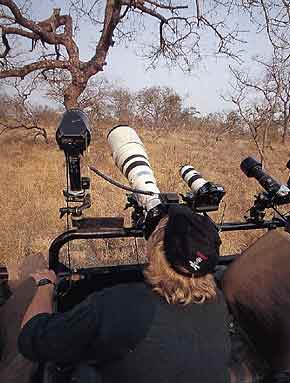
© Nigel Dennis
If you'd like to see some of Nigel's outstanding photographs, a visit to his website is highly recommended.
|
Bid to Boost Black Rhino Population
October 26, 2005
|
Twenty-one black rhinos (Diceros bicornis) have been released into the Zululand Rhino Reserve in KwaZulu-Natal province, South Africa.
The release this month is a further step in the WWF/Ezemvelo KZN Wildlife Black Rhino Range Expansion Project, which aims to boost the numbers of the critically endangered species by increasing the land available for their conservation and providing new territory in which they can breed quickly.
The Zululand Rhino Reserve, covering 24,000ha of savannah, is just such "new territory", where owners of more than 20 neighbouring properties recently removed their internal fences to create a large, barrier-free haven - the ideal breeding ground for the new residents.
“In just two years of this project, the black rhino has acted as a catalyst in creating about 40,000ha of barrier-free land for conservation,” said WWF project leader Dr Jacques Flamand.
Black rhino, which used to be the most numerous rhino species in the world, became critically endangered following a catastrophic poaching wave in the 1970s and 1980s that wiped out 96% of Africa’s wild black rhino population in only 20 years. At the lowest point, there were just 2,500 black rhinos left.
Intensive protection efforts by organizations like WWF and Ezemvelo KZN Wildlife (the body responsible for conservation in KwaZulu-Natal) have helped stabilize the situation and the number of black rhinos has gradually increased to around 3,600.
|
Today's picture: Lion's front paw, close-up.
October 26, 2005
|
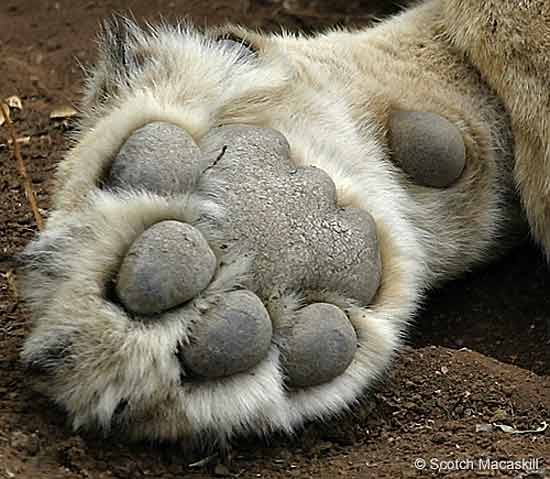
Photo Details: Close-up of the front paw of a female lion (Panthera leo), Mashatu Game Reserve, Tuli Block, Botswana.
Camera: Canon EOS Digital Rebel;
Lens: Canon 100-400mm IS zoom;
Focal Length: 400mm;
Shutter Speed: 1/500;
Aperture: f8;
ISO: 400
Here's how the lioness and her fellow pride-member were lying when the photograph was taken:
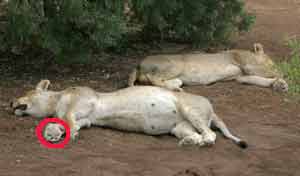
|
Today's picture: Hippo Looming Large
October 27, 2005
|
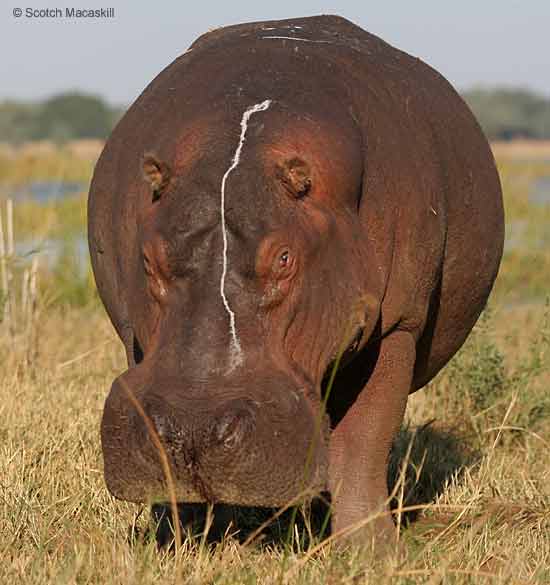
Photo Details:: Hippo (Hippopotamus amphibius) on small island in the Zambezi River watches warily as we pass by in a boat, unaware of how undigified he looks with a streak of egret droppings down his head - Lower Zambezi National Park, Zambia.
Camera: Canon EOS 350D;
Lens: Canon 80-200mm F2.8 zoom;
Focal Length: 150mm;
Shutter Speed: 1/3200;
Aperture: f4;
ISO: 400
|
Today's picture: Banded Mongoose, Mashatu Game Reserve, Botswana.
October 29, 2005
|
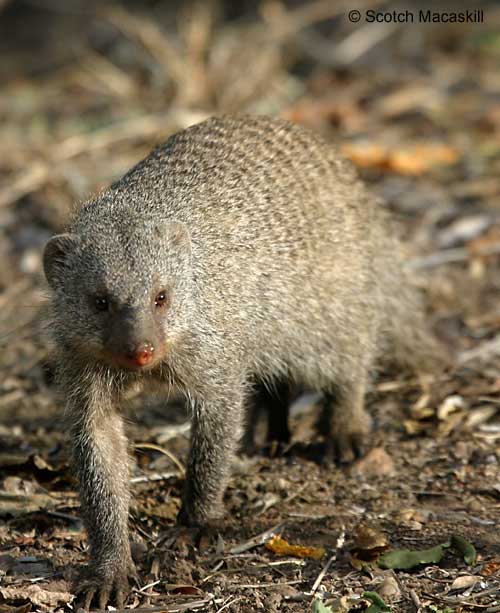
Photo Details: Banded mongoose (Mungos mungo) out foraging for food, Mashatu
Game Reserve, Botswana.
Camera: Canon EOS Digital Rebel;
Lens: Canon 100-400mm IS zoom;
Focal Length: 330mm;
Shutter Speed: 1/400;
Aperture: f6.3
ISO: 400.
During the day banded mongooses will head out, usually in a group or pack, to look for their favorite
food, mainly beetles, millipedes, crickets and the like.
They forage around in the undergrowth, scratching and turning up litter, leaves and twigs, much like chickens. They poke their noses into any openings and will use their front claws to extract prey from cracks and crevices too narrow for their snouts.
Although they will spread out to some extent when out foraging, they avoid forests or open country and keep in contact with constant chirps and
twitters.
If threatened, one of their defensive techniques is a "mob attack" in which they advance in a writhing
pack, heads reared, simultaneously growling and snapping. This suggests a single, large and relentless
adversary.
In his book, The Behavior Guide to African Mammals, Richard Despard Estes writes:
"The mobbing attacks of banded mongooses are so impressive that even animals as formidable as
servals and large dogs may be intimidated, not to mention lesser foes such as jackals, eagles, vultures
and herons.
"Packs have been known to to mob bushbucks, geese, and other harmless creatures somehow
perceived as potentially dangerous".
|
Today's picture: Elephant Mother and Young Ones
October 31, 2005
|
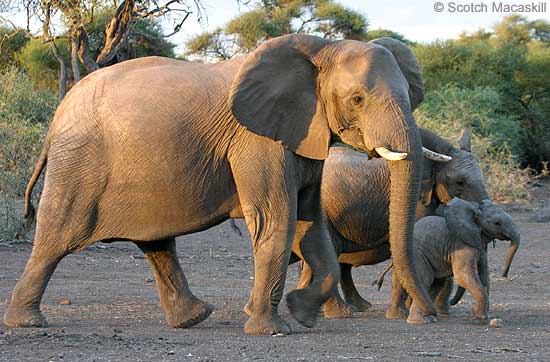
Photo Details: Elephant (Loxodonta africana) female protecting or sheltering a group of youngsters, Mashatu Game Reserve, Botswana.
Camera: Canon EOS Digital Rebel;
Lens: Canon 100-400mm IS zoom;
Focal Length: 100mm;
Shutter Speed: 1/125;
Aperture: f5.6;
ISO: 800
|
| |
| Back to top of page
|
|
Previous Entries
By Month
By Category
My Original Blog
2005 Entries
2004 Entries
2003 Entries
Who Am I?
Brief Bio

|

















